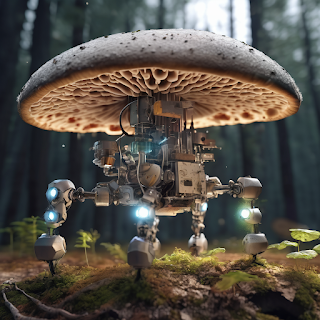Mushrooms have been fascinating organisms for centuries, serving as food, medicine, and even spiritual tools. However, recent advancements in science and technology have taken the role of fungi to a completely new level. Imagine a mushroom driving a robot! This is not science fiction but an exciting reality that reflects the potential of combining nature with technology.
In this article, we explore how mushrooms, specifically mycelium networks, are being harnessed to drive robots, showcasing the endless possibilities this field holds. From the role of fungi in bio-computing to their integration with artificial intelligence, these innovations are revolutionizing how we think about both robotics and nature.
Mycelium: The Hidden Power of Mushrooms
Mushrooms are the fruiting bodies of fungi, but beneath the surface lies an intricate web of mycelium. Mycelium is a network of thread-like structures known as hyphae that play a vital role in nutrient exchange in ecosystems. More importantly, mycelium acts as a bio-computer, transmitting electrical impulses similar to neurons in the human brain. This characteristic has led scientists to explore its potential in driving machines, particularly robots.
How Mycelium Can Power a Robot
Recent breakthroughs have shown that mycelium can be used to interact with electronic systems. Mycelium generates electrical impulses, which can be interpreted by robotic systems to control movement. These impulses are triggered by environmental factors such as light, moisture, and even chemical stimuli.
Researchers have developed interfaces that convert these biological signals into mechanical actions. In the case of robots driven by mycelium, sensors attached to the fungus detect the electrical signals and translate them into robotic commands. This allows the mushroom to "drive" the robot, guiding its movements across the ground. The potential for this technology could lead to eco-friendly robotics, biological computing systems, and even advancements in autonomous vehicles.
Applications of Fungi in Robotics and Bio-Computing
The ability of mushrooms to drive robots is just the tip of the iceberg. Researchers are exploring various applications of fungi in bio-computing, environmental sustainability, and even medicine. Below are some groundbreaking areas where fungi are making a difference:
1. Bio-computing with Mycelium Networks
Mycelium has shown promise in bio-computing, where it acts as a biological processor. Its natural ability to conduct electrical impulses makes it an excellent candidate for creating organic circuits. These circuits could one day replace silicon-based systems, leading to a more sustainable form of computing. The decentralized structure of mycelium also allows for parallel processing, making it an efficient and robust system for computation.
2. Environmental Robotics
Mushroom-driven robots could be the future of environmental monitoring. Since fungi are highly sensitive to environmental changes, they could be used to control robots that collect data on soil quality, moisture levels, and even air pollution. This could revolutionize agriculture, enabling farmers to monitor and respond to crop health in real-time.
3. Medical Innovations
The bio-computing properties of fungi are also being explored in the medical field. Mycelium networks could be used to create biosensors that monitor human health conditions. These sensors could track various metrics such as heart rate, blood sugar levels, and even detect early signs of diseases. The ability of fungi to interact with the human body in this way opens up new possibilities for non-invasive medical treatments.
The Future of Mushroom Robotics
While we are still in the early stages of understanding the full potential of mushrooms in robotics, the implications are staggering. The integration of biological systems with artificial intelligence could lead to more intuitive, adaptable robots. These robots could have a wide range of applications, from eco-friendly manufacturing processes to autonomous transportation systems.
Challenges to Overcome
As with any new technology, there are challenges to address. The biggest hurdle is ensuring that mycelium-driven robots can function reliably in various environments. Fungi are sensitive to changes in their surroundings, which could lead to erratic behavior in a robot. Researchers are working on ways to stabilize the interaction between biological and electronic systems to make mushroom robotics a viable option for large-scale use.
Conclusion: The New Frontier of Bio-Technology
Mushrooms are no longer just organisms found in forests—they are at the forefront of bio-technology, driving robots and opening doors to sustainable computing. The unique properties of mycelium make it an ideal candidate for developing eco-friendly, responsive robots that can adapt to their environment.
As we continue to explore the intersection of biology and technology, the potential applications of fungi in robotics and computing will only grow. This exciting new field promises to revolutionize industries and change the way we interact with both machines and nature.

